
Retail leaders are turning to Asia-Pacific (APAC) to gain insights into the future of their industry. The region is projected to account for 57% of global retail sales by 2028, according to Euromonitor. Why? High digital disruption and maturity. Countries like China, South Korea, Singapore and Japan in particular have been faster than most to embrace digital retail. In fact, from 2013 to 2023, eCommerce sales in the region increased by 630%, making up 46% of the world’s online retail sales.
With this in mind, retailers around the world are taking inspiration from the likes of Temu, JD.com, and Uniqlo – all at the cutting edge of retail innovation – as they seek to capture the attention of a new generation of buyers and deliver experiences that blend the digital and physical worlds in effective ways.
As APAC continues to lead the way, here are five standout trends from across the region that retailers should take notice of as they plan their futures:
1. Quality and affordability
Retail in APAC is proving that consumers don’t just want low prices — they want high-quality products at a justifiable cost. With 72% of APAC shoppers concerned about rising expenses (Euromonitor), they are embracing value-driven retail models that maximize both savings and quality. A prime example is the rapid growth of membership-based warehouse retailers like Sam’s Club in China, where bulk-buying is booming among middle-class and affluent shoppers. These consumers aren’t just seeking discounts; they’re willing to commit to memberships for access to premium products at wholesale prices, redefining what affordability means.
This trend signals a broader shift: affordability isn’t about spending less; it’s about getting more for what you spend. APAC retailers are succeeding by blending exclusivity, bulk discounts, and premium offerings, proving that affordable luxury is the future. And this can be true for the rest of the world, too. Shoppers are becoming increasingly value-conscious, and brands that can balance high quality with accessible pricing will take the lead among consumer favorites.
2. Tailored personalization with AI
“Success in today’s market hinges on building a deeper trust with consumers that transcends mere transactions and fosters deeper loyalty,” says Michael Cheng and Rakesh Mani, Asia Pacific Consumer Markets Co-Leaders at PwC.
AI has become a key driver in this transformation, helping retailers understand purchasing behavior, anticipate needs, and deliver tailored offerings. With 68% of APAC consumers viewing AI positively, brands that embrace AI-driven personalization are more likely to strengthen customer relationships.
For example, Temu leverages AI algorithms to refine the shopping experience, analyzing user behavior to provide personalized recommendations and optimize product discovery. Renowned cosmetics brand Shiseido takes personalization a step further with AI-powered virtual beauty consultations, ensuring customers receive tailored product suggestions based on their skin type.
But AI isn’t just limited to generating product suggestions. Qiping Sun, Regional Vice President APAC at LS Retail, emphasizes AI’s growing role in customer retention through smarter promotions. In an interview with Inside Retail, he explains, “Every retailer has their way of managing promotions, but how do you get real impact from them? Whether to move slow-moving items or use vendor discounts, AI-driven analysis ensures promotions attract and retain customers.”
As AI capabilities continue to evolve, retailers that embrace hyper-personalization and predictive insights will be best positioned to foster lasting customer loyalty in an increasingly competitive market.
3. Social-driven shopping
Retailers in Asia-Pacific are leading the charge in social commerce, transforming how consumers discover and buy products. With over two-thirds of APAC shoppers preferring online shopping over in-store experiences, platforms like Facebook, Instagram, TikTok, and regional giants like Tokopedia in Indonesia have become virtual marketplaces where transactions happen in real-time. The region’s social commerce market is booming, projected to grow at a compound annual growth rate of 10.6% by 2028, as brands leverage these platforms to connect with audiences in more interactive and engaging ways.
In particular, the rise of short-form video content has been a key driver of online shopping engagement. For example, South Korean beauty brands have experienced a resurgence in popularity, driven by social media trends and consumers' interest in ingredient-focused skincare. Brands like Anua, Medicube, and Skin1004 have revitalized the market by leveraging platforms such as Instagram and TikTok to showcase their products to a wide range of audiences and keep their customers up to date on the latest releases.
As Jo Ling Sun, Senior Trends Analyst at GWI, explains, “Those who watch short-form videos on their mobile devices are over 2x more likely to complete their purchase journey on mobile.” This shift means that scrolling through a TikTok feed can turn into a shopping spree in seconds, fueled by algorithm-driven recommendations, influencer endorsements, and limited-time offers. Brands that master the art of engaging, visually rich content can unlock a whole new channel for sales, enticing both new and returning customers to shop.
4. Emphasis on sustainability
Consumers are making conscious choices to reduce their environmental impact, with 9 out of 10 saying they would stop buying from brands that fail to offer sustainable options (Delta Global). This shift is pushing retailers to innovate, rethink packaging, and adopt greener materials to stay relevant in an increasingly eco-conscious market.
Nowhere is this shift more evident than in everyday essentials like household cleaning products. Brands like The Laundry Pods in Malaysia and Singapore’s Bio-Home are answering the call with bio-enzyme pods in plastic-free packaging and fully dissolvable detergent sheets in paperboard boxes, respectively. “Eco-friendly detergent formulations with ingredients such as plant extracts, essential oils, enzymes, and natural preservatives are becoming increasingly popular,” says Naveed Khan, a consumer analyst at GlobalData, emphasizing that consumers are looking for products with minimal environmental impact throughout their lifecycle.
Beyond cleaning products, this sustainability movement is transforming the fashion industry, particularly in the luxury market, where second-hand shopping is booming despite the dominance of fast fashion. Recognizing the demand, retailers like Uniqlo are stepping up, prioritizing sustainable materials, reducing waste, and investing in environmental projects, such as partnering with UNESCO to support ocean-education initiatives.
5. Fast and convenient delivery
Today's consumers have a "now" mindset, expecting instant gratification the moment they decide to make a purchase, especially when shopping online. According to a study from DHL eCommerce, more than two in three online shoppers in APAC say that next-day delivery is a must, with 74% in Thailand and 72% in India prioritizing speed. Furthermore, 90% of customers believe the clock starts ticking the moment they place an order, not when the package is handed to the carrier. This puts pressure on retailers to enhance transparency, streamline order processing, and communicate clearly to meet rising expectations.
To keep up with these demands, APAC retailers are reinventing fulfillment strategies. JD.com has seamlessly integrated store and warehouse operations, enabling deliveries within just 30 minutes in select areas. Meanwhile, Lazada, the leading eCommerce platform in Southeast Asia, is doubling down on logistics, leveraging an extensive network of fulfillment centers and last-mile delivery partners to offer same-day delivery in key cities across the region.
Building a brighter, digital future
APAC retailers may be leading the charge in adopting new technologies, but retailers worldwide are quickly following suit — investing in digital capabilities, rethinking their pricing models, and embracing sustainability to stay competitive.
At LS Retail, we work with businesses across the globe to help them navigate this evolving landscape, leveraging unified retail software solutions to drive growth and stay ahead of emerging trends. Want to explore how our technology can empower your business? Get in touch with our experts.

